Trusted Transmission Services Are Just Around The Corner
If you think there’s a problem with your automatic transmission, don’t wait to have a professional look at it. Richmond Ford West provides comprehensive, convenient transmission services and repairs, and our highly-trained team of technicians are happy to assist you anytime your automatic transmission needs its fluid checked.
Richmond Ford West is proud to check the automatic transmission fluid for our friends around Short Pump, Ashland, and Glen Allen. To have your transmission fluid looked at, schedule an appointment at Richmond Ford West today.
What Is The Correct Way To Check Transmission Fluid
Check the Level With the engine warmed up, leave the car idling in park on a level surface. Pull out the dipstick, wipe it clean, replace it slowly, and then pull it back out. Check the fluid levelhow high the fluid comes up on the dipstickagainst the full and low or fill marks on the dipstick.
What Are The Signs Of Low Transmission Fluid
There are generally a few signs and symptoms you can be on the lookout for to let you know that your transmission fluid may be low and that you should give it a look in the first place. Obviously this isn’t the kind of thing you’re going to do every time you go out for a drive, so something has to happen to make you want to check the transmission fluid levels.
Low transmission fluid levels can cause some serious problems with your transmission seizing up and failing on you, the cost of replacing damaged transmission can be incredibly expensive. The complete replacement of your transmission may cost you around $4,000 or more, so you definitely don’t want to slack on making sure your fluid levels are where they need to be. If you’re experiencing any of these symptoms, make sure you take a look at your fluid levels to find out what’s going on.
Read Also: Burn Hole In Car Seat
Do You Check Transmission Fluid While The Car Is Running
Transportation is one of the most important activities among the busy lives of millions of people of different occupations and ages. Some of us prefer to use public transport, whereas others prefer to choose private transport.
Both have their own pros and cons but owning a private transport such as a car also comes with the responsibility of diagnosing it which you can learn about in the extract below.
Why Do You Check Transmission Fluid With The Car Running

Transmission fluid level is an important component of a car since the fluid not only optimizes the engine performance by lubricating its moving parts but also prevents oxidation and rusting.
Which is why it is necessary to check the transmission fluid when the car engine is running because of the following reasons:
Don’t Miss: What Stores Can I Use My Synchrony Credit Card
Do You Check Transmission Fluid With The Car Running
It’s worth noting before you take the time to check your transmission fluid your vehicle should be running when you do this. It’s always best to check transmission fluid when it’s warm and the car is running rather than from cold. You should have your vehicle in neutral or park with your parking brake on. You don’t want to do this with an engine that’s been running for hours and is very hot, but if it’s been allowed to warm up for a moment that’s a good time to do it.
How To Check Your Transmission Fluid
Your transmission is just as important as the engine in your vehicle. Without it, your car may be able to start but will go nowhere fast. Keeping your transmission in good condition is vital and as with any major component on your vehicle, protection begins with maintenance. Checking your transmission fluid levels, color, and even scent will help you understand what condition your transmission is in. Regular flushes and good habits such as using your parking brake when stopped and shifting to drive from reverse only at a complete stop are great ways to help extend the life of your transmission. Not sure how to check your transmission fluid? Follow our quick reference guide!
Recommended Reading: How To Repair Damaged Clear Coat On A Car
How To Change Transmission Fluid
1. Warm up the EngineThe point of changing your transmission fluid is to completely remove the old, dirty fluid and replace it. Get all the old fluid out, it is best if the car is warm. This will heat the old fluid and make it much easier for it to flow out when you remove the transmission pan. Set the parking brake and run the car for five to ten minutes before getting it up on jack stands so you can get underneath it.
2. Remove the Transmission PanThe transmission pan is located under the car towards the middle. Place a two-gallon plastic catch bucket underneath the transmission pan and start removing the bolts from one side. Be careful of any hot exhaust or engine parts.
3. Empty the FluidAs you continue to remove all the bolts, the fluid will start to drain out of the pan. Once you have removed all of them, you will be able to completely disconnect the pan and dump the remaining fluid into your bucket. There is a gasket between the pan and the transmission that may need to be pried apart gently with a screwdriver.
4. Clean the SurfacesOnce you have drained the pan completely, clean off all the surfaces with a clean rag or paper towel. Inspect the area for any metal shavings or burnt smells. These could be signs that you need to schedule service for your transmission.
Some vehicles, however, use a wire mesh filter that doesn’t need to be replaced. If this is the case with your vehicle, simply clean the filter out thoroughly , and put it back.
What Should You Do If Your Transmission Fluid Is Low
If your transmission fluid is low, you can add some yourself using a funnel. However, you should make sure you get the right kind and do not add too much. Both mistakes can lead to serious problems within your transmission. Overfilling transmission fluid can cause seals to blow or cause your transmission to act unstable.
In the short term, adding some transmission fluid yourself can be more cost-effective. Often, it will fix the immediate problem. At the same time, transmissions are closed systems, so if your transmission fluid is low, that most likely means there is another larger problem, such as a leak. Because of this, you should still take your car to a trusted transmission expert to be diagnosed.
As a general rule, you should get your transmission fluid replaced every 100,000 miles and keeping up with any required transmission fluid services in between will help prolong the life of your cars transmission. If you notice a leak or changes in how your car runs, make it a priority to get a Vehicle Courtesy Check by transmission experts to prevent a costly transmission repair.
Recommended Reading: How To Make Aroma Bead Vent Clips
How Often Should I Check My Cars Fluids
Regular vehicle maintenance is essential to keeping your car running for years and avoiding breakdowns. An essential part of car maintenance that you can do at home is checking the different fluids under the hood. Heres what you need to know about inspecting and maintaining the proper fluid levels in your vehicle:
Do I Need To Check My Transmission Fluid
Yes, you do. Automatic transmissions require transmission fluid to operate properly. Without the right level and right quality of transmission fluid, you are damaging your transmission every time you drive. Manual transmissions can also use transmission fluid or transmission oil mostly for lubrication.
Also Check: Average Commission For Car Salesman
Engine On Or Off To Check Transmission Fluid
- Hello Everyone! Let us know what you would spend a $50 Amazon gift card on, HERE For a chance to win a $50 Amazon Gift Card!
Go with what the manufacturer says
Quote-TerrastrifeNewest addition-
Axel Kain said:… its so simple, yet highly misunderstood. cool means a cool engine, but running, after you have cycled through the gears…
nodrogkam said:touring – the hot mark is higher than the cold mark by about an inch. your camry doesnt have a dipstick for the tranny? thats hard to believe. is the hole plugged by a rag or something?
nodrogkam said:if anyone is going to buy a new car, could they check the tranny fluid before they test drive? cos as far as i can remember, our brand new HL came with fluid over the hot line even when cold. Also all of our cars after transmission fluid service /flush or drain/fill, have always come back with fluid over hot line. must be a reason for it. i asked my mechanic and he said thats how it is. my haynes disagrees…sigh.
How To Check Transmission Fluid Level

The transmission fluid dipstick is similar to the oil dipstick, while the oil dipstick measures the level of the cars engine oil, transmission dipsticks measure the level of transmission fluid in your vehicle. Keep in mind many transmission troubles are due to low fluid levels. If the fluid is low, it is likely there is a leak and it will need to be found and repaired by a professional right away. If you need to add additional fluid, be careful not to overfill the reservoir. Overfilling transmission fluid can cause the fluid to foam, putting excess pressure on the transmission, and forcing fluid out of the vent or a seal. This can result in slipping and instability.
You May Like: Aarp Auto Rental Discounts
Changing Transmission Fluid Yourself Vs Having A Shop Do It
According to most manufacturers, you should change your transmission fluid once every 30,000 to 60,000 miles. This will keep the fluid from getting dirty and gumming up the gears, which can happen as the fluid heats up and cools down over and over again. You can either take your car into a shop to have them change the transmission fluid or you can do it yourself.
Most shops will charge somewhere between $80 and $250 for a transmission fluid and filter change. If you do it yourself, it should only be between $50 to $100 for materials like a plastic pan, new fluid, and a new filter. This doesnt count the cost of tools and jack stands, which you will need if youre going to change your own fluid.
When Is It Best To Check Transmission Fluid & Level
There is no best time to check your transmission fluid per se, but it should be part of your routine maintenance. It would be good to get into a routine of checking all your fluids every 3-5,000 miles or when ever you get an oil change.
This interval will give you an idea of how the transmission fluid looks after a certain period of time in between getting a transmission fluid and filter change or flush .
Don’t Miss: Who Takes Carcareone Credit Card
How To Check Your Automatic Transmission Fluid
At Richmond Ford West, we know how vital a healthy transmission is to your vehicle’s performance. One of the best ways to keep your transmission working properly is to check its fluid levels regularly. By doing so, you may be able to catch small mechanical issues before they spell huge problems for your transmission.
You can always turn to the Service Center at Richmond Ford West for comprehensive, professional transmission services. However, we know many of our friends around the Glen Allen, Short Pump, and Ashland area like taking matters into their own hands, and checking their transmission’s fluid themselves.
A technician is usually needed to check manual transmission fluid-the vehicle needs to be on a hoist to reach a plug underneath the transmission. However, if you drive an automatic and fall into the DIY camp, keep reading to find out how to check fluid levels in your transmission!
Our Family Handyman Automotive Expert Will Show You How To Check The Transmission Fluid In Your Car To Prevent Damage
Engine oil isnt the only fluid in your car that needs to be checked and changed. Transmission fluid is another important one. You can check, top off and change your transmission fluid at home, but a transmission fluid flush is usually best left to the pros. Heres why and how to check your transmission fluid.
Why To Check Transmission Fluid
Transmission fluid lubricates the parts in your transmission and helps to disburse heat. If that fluid is too low or too old, it cant do its job.
Driving with low transmission fluid can cause shifting problems and transmission damage. Repairing or replacing a damaged transmission is expensive it can cost thousands.
Fortunately, DIY transmission fluid checks are quick and easy, so you can maintain optimal performance and prevent damage on the road. All you need to check transmission fluid is a clean shop rag.
You May Like: Arizona Title Transfer Without Notary
Locate The Transmission Fluid Dipstick
When the engine is warm, pop the hood and locate the transmission fluid dipstick. In vehicles with in-line engines, the dipstick is usually behind the oil dipstick, sitting closer to the rear of the engine towards the windshield. In a front-wheel-drive vehicle, the dipstick usually sits in the transaxle to the right of the oil dipstick.
The dipstick should have a label indicating that its for transmission fluid. Its often a bright red or yellow color for easy identification.
If you have a manual transmission, you will need to elevate the vehicle on a hoist. You or your mechanic will need to reach a drain plug, which is generally only accessible by raising the car.
Check Automatic Transmission Fluid
The majority of car manufacturers will tell you to replace your automatic transmission fluid anywhere from 100,000 to 150,000 miles. If you arent sure, check your owners manual to see the exact recommendation from your vehicles manufacturer.
However, if you were to ask 10 professional mechanics how often to change your transmission fluid, the majority would likely tell you the transmission fluid change interval should be much sooner.
Either way, you should regularly inspect the level of transmission fluid that you have. If you have a dipstick and filler tube in your transmission, you can inspect the fluid level yourself. Otherwise, have a mechanic inspect your transmission fluid for you.
Here are a few helpful tips to investigate the condition of your automatic transmission fluid:
Also Check: How To Keep Car Doors From Freezing Shut In Winter
Transmission Fluid Tips And Maintenance
Maintain proper transmission fluid levels to keep your vehicle running smoothly. Here are a few tips to help preserve your car and transmission:
- Checking transmission fluid levels can be more difficult depending on the make and model of your car. Consult your owners manual before performing any of the steps above.
- Check levels at least once per year. Many mechanics will do this as part of a routine service. You can do this on your own more often as well to ensure optimal performance.
- Many experts recommend changing your transmission fluid every 30,000 to 50,000 miles.
Do You Check Transmission Fluid While Idling

When the engine is at a normal running temperature, it is best to check the transmission fluid level. When the engine is running, remove the dipstick and wipe it with a clean, non-fluffy cloth after it has been cleaned. Make sure you replace it gently so that you dont force the dipstick tube to re-press the fluid.
Read Also: How To Remove Duct Tape Residue Off Car Paint
Where Can You Find Transmission Fluid Services
If youre looking for a team of Colorado transmission experts, AAMCO Colorado staffs every location with well-trained, knowledgeable mechanics. Prioritizing transmission fluid service can mean the difference between a simple repair and a much more costly full transmission repair. Especially if you find that your transmission fluid level is low, you should make an appointment with your local AAMCO Colorado repair shop to get your problem diagnosed. Schedule an appointment today with your local AAMCO Colorado service center.
